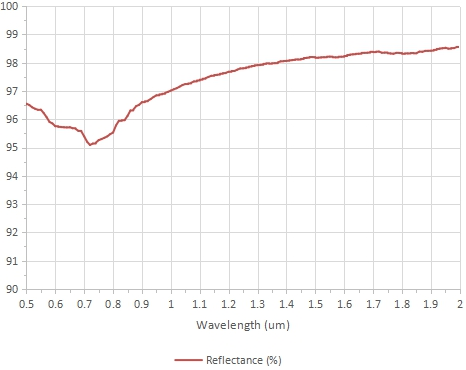Reflective fiber optic collimator

Reflective fiber optic collimator, using a 90 ° off axis parabolic reflector coated with protective silver film, with a wavelength coverage of 450nm~20um. Unlike a lens, the focal length of a metal reflector remains constant over a wide wavelength range. Due to this inherent property, parabolic reflector collimators can collimate light of different wavelengths without the need for adjustment, making them an ideal choice for collimating polychromatic light.
Features
450nm~20um ultra wide wavelength coverage range;
There is almost no color difference within the entire reflection band, with a zero focal shift;
Integrated design, direct insertion and use, no need for adjustment;
Plating protective silver film, with an average reflectivity of>97.5% (450nm 2um) and>96% (2-20um);
Precision craftsmanship, compact size, small collimation spot, and convenient installation and use.
Conventional single lenses have chromatic aberration and focal shift at different wavelengths. Therefore, when changing the wavelength of use, it is generally necessary to readjust the optical path to achieve better collimation or coupling effect. The lens and fiber position of conventional single lens collimators are fixed, so their applicable wavelength range is narrow;
The achromatic lens group can reduce the focal shift caused by wavelength changes to a certain extent, which greatly expands the wavelength range compared to conventional single lenses. However, there are currently few integrated fiber optic collimators that use achromatic lenses, which limits their range of use. If an achromatic lens is used for collimation or coupling, it is generally necessary to choose a lens and a series of installation and adjustment fixtures, which is not as convenient and easy to use as an integrated fiber optic collimator;
Whether it is a conventional single lens or an achromatic lens, even if the antireflection film is coated, its surface reflectivity and material transmittance have a certain wavelength range. It is difficult to achieve relatively consistent and efficient optical alignment and coupling performance in a large wavelength range (such as more than 700nm).
Parameter
500nm~2um reflectance curve
Coating | Protective silver film | |||
Wavelength range
| 450nm - 20um | |||
Reflection focal length | 7mm | 15mm | 33mm | 50.8mm |
Optical aperture | 7.5mm | 11mm | 22mm | |
Collimated beam diametera | 2mm | 4mm | 8.5mm | 12mm |
MirrorNA | 0.4 | 0.36 | 0.167 | 0.216 |
Average reflectance | >97.5% (0.45 - 2µm), >96% (2 - 20 µm) | |||
Surface quality | 40-20Scratch-Dig | |||
Surface roughness | < 100 Å RMS | |||
Reflected wavefront error | λ/4 @ 633nm | |||
Full angle divergence angle of collimated beamb | 0.02° | |||
Pointing error c (FC/PC and FC/APC) | < 10mrad | |||
*Using NA 0.13 fiber optic.
*Approximate divergence angle. The actual divergence angle is based on the fiber MFD, and 0.02 ° is obtained from the 543nm light output of the fiber with an MFD of 3.4 ± 0.5 µ m @ 460nm.
*For SMA connectors using metal inserts, pointing errors cannot be guaranteed.

If a multimode fiber with a NA of 0.22 is docked, the theoretical calculation value of the collimated output beam diameter is about Ø 3.1mm, and the fiber core diameter has an impact on this. If it is too thick, it will lead to a decrease in the collimation effect.
The data provided in this technical specification are all historical data of the product. Due to slight differences in customized processing and different batches of materials, the actual indicators are slightly different from the above historical data. The actual measured values shall prevail.
If the user uses a wide wavelength range and a thicker fiber core diameter, the positioning accuracy of the fiber connector used is poor. In actual use, there may be differences with the optimal performance of the product.
